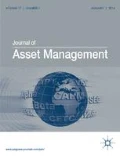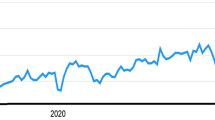Abstract
The rising sustainability awareness among regulators, consumers and investors results in major sustainability risks of firms. We construct three ESG risk factors (Environmental, Social and Governance) to quantify the ESG risk exposures of firms. Taking these factors into account significantly enhances the explanatory power of standard asset pricing models. We find that portfolios with pronounced ESG risk exposures exhibit substantially higher risks, but investors can compose portfolios with lower ESG risks while keeping risk-adjusted performance virtually unchanged. Moreover, investors can measure the ESG risk exposures of all firms in their portfolios using only stock returns, so that even stocks without qualitative ESG information can be easily considered in the management of ESG risks. Indeed, strategically managing ESG risks may result in potential benefits for investors.


Similar content being viewed by others
Notes
Private investments are needed to close the €180-billion gap in additional yearly investments needed to meet the SDGs (European Commission 2018).
There is an ongoing debate regarding the impact of ESG integration on financial performance. Though there is evidence for CSR affecting corporate performance [for example, Hong and Kacperczyk (2009); El Ghoul et al. (2011); Chava (2014) and Eccles et al. (2014)], literature investigating the performance of ESG portfolios shows mixed results. Papers covering the US market [for example, Derwall et al. (2005); Galema et al. (2008); Dorfleitner et al. (2018); Gloßner (2018) and Amiraslani et al. (2019)] and the European market (Brammer et al. 2006; Mollet and Ziegler 2014; Auer 2016; Auer and Schuhmacher 2016 and Barth et al. 2019b) indicate a partly positive relation between CSR and performance for the US, whereas the evidence for Europe does not show a significant performance impact.
Similarly, Jin (2018) applies one aggregated ESG-related factor to evaluate U.S. equity funds and finds that fund managers tend to hedge ESG-related systematic risks.
Kendall’s rank correlations are slightly lower in magnitude, but p values remain below 1%.
Although we use ESG ratings in the construction of the ESG factors, ESG exposures should be largely independent of greenwashing and incomplete data due to diversification effects.
E- and S-ratings for each firm are benchmarked against the firm’s industry peers. Governance scores are calculated against the firm’s country of headquarter.
We thank Kenneth R. French for supplying this data for Europe at http://mba.tuck.dartmouth.edu/pages/faculty/ken.french/data_library.html. Since these European factor returns are calculated in US dollars, we converted them into Euro following Glück et al. (2019).
The number of stocks in the portfolios SL, BL, SH and BH ranges between 69 in 2003 to 139 in 2016.
We apply an F-test for nested models, as the 6F-FFC model is a subset of the 9F-ESG model.
Detailed results, including all coefficient estimates, are available upon request.
Shapely values account for the interplay between the individual factors. For a deeper discussion of methods to decompose R2, see Klein and Chow (2013).
Taking into account that returns on quintile portfolios could also be driven by factor exposures, we calculate alphas from the 6F-FFC model and again find no significant relationship between ESG exposures and alphas. These results are available upon request.
Compare the discussion of the differences between ESG ratings and ESG exposures in “ESG exposures versus ESG ratings” section.
For brevity, we report significant results only. Detailed results are available upon request.
Results are available upon request.
References
Ameer, R. 2016. Usefulness of ASSET4 ESG for Socially Responsible Investing in a Small Economy. Journal of Investing 25(2): 125–135.
Amiraslani, H., K.V. Lins, H. Servaes, and A.M. Tamayo. 2019. The Bond Market Benefits of Corporate Social Capital. Brussels: European Corporate Governance Institute.
Aon Benfield, 2017. Weather, Climate & Catastrophe Insight. http://thoughtleadership.aonbenfield.com/Documents/20180124-ab-if-annual-report-weather-climate-2017.pdf. Accessed 1 Mar 2019.
Auer, B.R. 2016. Do Socially Responsible Investment Policies Add or Destroy European Stock Portfolio Value? Journal of Business Ethics 135(2): 381–397.
Auer, B.R., and F. Schuhmacher. 2016. Do Socially (Ir)responsible Investments Pay? New Evidence from International ESG Data. Quarterly Review of Economics and Finance 59: 51–62.
Barth, F., C. Eckert, N. Gatzert, and H. Scholz. 2019a. Spillover Effects from the Volkswagen Emissions Scandal: An Analysis of Stock, Corporate Bond, and Credit Default Swap Markets. Nürnberg: Friedrich-Alexander-Universität Erlangen-Nürnberg.
Barth, F., B. Hübel, and H. Scholz. 2019b. ESG and Corporate Credit Spreads. Nürnberg: Friedrich-Alexander-Universität Erlangen-Nürnberg.
Borgers, A., J. Derwall, K. Koedijk, and J. ter Horst. 2015. Do Social Factors Influence Investment Behavior and Performance? Evidence from Mutual Fund Holdings. Journal of Banking & Finance 60: 112–126.
Brammer, S.J., C. Brooks, and S. Pavelin. 2006. Corporate Social Performance and Stock Return UK Evidence form Disaggregate Measures. Financial Management 35(3): 97–116.
Carhart, M. 1997. On Persistence in Mutual Fund Performance. Journal of Finance 52(1): 57–82.
CFA Institute. 2017. Environmental, Social and Governance Survey. https://www.cfainstitute.org/en/research/survey-reports/esg-survey-2017. Accessed 1 Mar 2019.
Chatterji, A., R. Durand, D. Levine, and S. Touboul. 2015. Do Ratings of Firms Converge? Implications for Managers, Investors and Strategy Researchers. Strategic Management Journal 37(8): 1597–1614.
Chava, S. 2014. Environmental Externalities and Cost of Capital. Management Science 60(9): 2223–2247.
Derwall, J., N. Guenster, R. Bauer, and K. Koedijk. 2005. The Eco-Efficiency Premium Puzzle. Financial Analysts Journal 61(2): 51–63.
Dong, X., S. Feng, S. Parida, and Z. Wang. 2019. Corporate Social Responsibility Exposure and Performance of Mutual Funds. Journal of Investing 28(2): 53–65.
Dorfleitner, G., G. Halbritter, and M. Nguyen. 2015. Measuring the Level and Risk of Corporate Responsibility—An Empirical Comparison of Different ESG Rating Approaches. Journal of Asset Management 16(7): 450–466.
Dorfleitner, G., S. Utz, and M. Wimmer. 2018. Patience Pays Off—Corporate Social Responsibility and Long-Term Stock Returns. Journal of Sustainable Finance & Investment 8(2): 132–157.
Eccles, R.G., I. Ioannou, and G. Serafeim. 2014. The Impact of Corporate Sustainability on Organizational Processes and Performance. Management Science 60(11): 2835–2857.
Edmans, A. 2011. Does the Stock Market Fully Value Intangibles? Employee Satisfaction and Equity Prices. Journal of Financial Economics 101(3): 621–640.
El Ghoul, S., O. Guedhami, C.C.Y. Kwok, and D.R. Mishra. 2011. Does Corporate Social Responsibility Affect the Cost of Capital? Journal of Banking & Finance 35(9): 2388–2406.
El Ghoul, S., and A. Karoui. 2017. Does Corporate Social Responsibility Affect Mutual Fund Performance and Flows? Journal of Banking & Finance 77: 53–63.
European Commission. 2018. Sustainable Finance: Making the Financial Sector a Powerful Actor in Fighting Climate Change, 24 May, http://europa.eu/rapid/press-release_IP-18-3729_en.htm. Accessed 1 Mar 2019.
Fama, E.F., and K.R. French. 1993. Common Risk Factors in the Returns on Stocks and Bonds. Journal of Financial Economics 33(1): 3–56.
Fama, E.F., and K.R. French. 2015. A Five-Factor Asset Pricing Model. Journal of Financial Economics 116(1): 1–22.
Frank, J., and J. Massey. 1951. The Kolmogorov–Smirnov Test for Goodness of Fit. Journal of the American Statistical Association 46(253): 68–78.
Galema, R., A. Plantinga, and B. Scholtens. 2008. The Stocks at Stake: Return and Risk in Socially Responsible Investment. Journal of Banking & Finance 32(12): 2646–2654.
Gloßner, S. 2018. The Price of Ignoring ESG Risks. Eichstaett-Ingolstadt: Catholic University of Eichstaett-Ingolstadt.
Glück, M., B. Hübel, and H. Scholz. 2019. Currency Conversion of Fama/French Factors: How and Why?. Nürnberg: Friedrich-Alexander-Universität Erlangen-Nürnberg.
Görgen, M., A. Jacob, M. Nerlinger, R. Riordan, M. Rohleder, and M. Wilkens. 2018. Carbon Risk. Augsburg: University of Augsburg.
Global Sustainable Investment Alliance GSIA. 2017. Global Sustainable Investment Review 2016. 28 March 2017, http://www.gsi-alliance.org/wp-content/uploads/2017/03/GSIR_Review2016.F.pdf. Accessed 1 Mar 2019.
Henke, H.M. 2016. The Effect of Social Screening on Bond Mutual Fund Performance. Journal of Banking & Finance 67: 69–84.
Henriksson, R., J. Livnat, P. Pfeifer, and M. Stumpp. 2019. Integrating ESG in Portfolio Construction. Journal of Portfolio Management 45(4): 67–81.
Hong, H., and M. Kacperczyk. 2009. The Price of Sin: The Effects of Social Norms on Markets. Journal of Financial Economics 93(1): 15–36.
Ince, O.S., and R.B. Porter. 2006. Individual Equity Return Data from Thomson Datastream: Handle With Care! Journal of Financial Research 29(4): 463–479.
Jin, I. 2018. Is ESG a Systematic Risk Factor for US Equity Mutual Funds? Journal of Sustainable Finance & Investment 8(1): 72–93.
Kempf, A., and P. Osthoff. 2008. SRI Funds: Nomen est Omen. Journal of Business Finance and Accounting 35(9–10): 1276–1294.
Klein, R.F., and V.K. Chow. 2013. Orthogonalized Factors and Systematic Risk Decomposition. Quarterly Review of Economics and Finance 53(2): 175–187.
Kruskal, W. 1987. Relative Importance by Averaging Over Orderings. American Statistician 41(1): 6–10.
Kruskal, W.H., and W.A. Wallis. 1952. Use of Ranks in One-Criterion Variance Analysis. Journal of the American statistical Association 47(260): 583–621.
Levene, H. 1960. Robust testes for equality of variances. In Contributions to Probability and Statistics, edited by I. Olkin, 278–292. Stanford Univ. Press, Palo Alto, CA.
Lins, K.V., H. Servaes, and A. Tamayo. 2017. Social Capital, Trust, and Firm Performance: The Value of Corporate Social Responsibility During the Financial Crisis. Journal of Finance 72(4): 1785–1824.
Mollet, J.C., and A. Ziegler. 2014. Socially Responsible Investing and Stock Performance: New Empirical Evidence for the US and European Stock Markets. Review of Financial Economics 23(4): 208–216.
Newey, W.K., and K.D. West. 1987. A Simple, Positive Semi-Definite, Heteroskedasticity and Autocorrelation Consistent Covariance Matrix. Econometrica 55(3): 703–708.
Newey, W.K., and K.D. West. 1994. Automatic Lag Selection in Covariance Matrix Estimation. Review of Economic Studies 61(4): 631–653.
Nofsinger, J., and A. Varma. 2014. Socially Responsible Funds and Market Crises. Journal of Banking & Finance 48: 180–193.
Parguel, B., F. Benoît-Moreau, and F. Larceneux. 2011. How Sustainability Ratings Might Deter ‘Greenwashing’: A Closer Look at Ethical Corporate Communication. Journal of Business Ethics 102(1): 15.
Renneboog, L., J. Ter Horst, and C. Zhang. 2008. Socially Responsible Investments: Institutional Aspects, Performance, and Investor Behavior. Journal of Banking & Finance 32(9): 1723–1742.
Scholtens, B. 2017. Why Finance Should Care About Ecology. Trends in Ecology & Evolution 32(7): 500–505.
Statman, M. 2016. Classifying and Measuring the Performance of Socially Responsible Mutual Funds. Practical Applications 4(3): 43–46.
Statman, M., and D. Glushkov. 2016. Classifying and Measuring the Performance of Socially Responsible Mutual Funds. Journal of Portfolio Management 42(2): 140–151.
Stellner, C., C. Klein, and B. Zwergel. 2015. Corporate Social Responsibility and Eurozone Corporate Bonds: The Moderating Role of Country Sustainability. Journal of Banking & Finance 59: 538–549.
Trinks, P.J., and B. Scholtens. 2017. The Opportunity Cost of Negative Screening in Socially Responsible Investing. Journal of Business Ethics 140(2): 193–208.
United Nations. 2015. Transforming our World: The 2030 Agenda for Sustainable Development. 21 October, Resolution A/RES/70/1.
Utz, S., and M. Wimmer. 2014. Are They Any Good at All? A Financial and Ethical Analysis of Socially Responsible Mutual Funds. Journal of Asset Management 15(1): 72–82.
Welch, B.L. 1938. The Significance of the Difference Between Two Means When the Population Variances are Unequal. Biometrika 29: 350–362.
Wimmer, M. 2013. ESG-Persistence in Socially Responsible Mutual Funds. Journal of Management and Sustainability 3(1): 9–15.
Acknowledgements
We are grateful for helpful comments and suggestions from Matthias Bank, Rainer Baule, David Buckle, Ulf Erlandsson, Xavier Gerard, Binam Ghimre, Bart van der Grient, Dennis Huber, Marielle de Jong, Antoine Mandel, Jason MacQueen, Sarah McCarthy, Zoltán Nagy, Martin Nerlinger, Satya Pradhuman, Cyrus Ramezani, Martin Rohleder, Stephen Satchell, Ingrid Tierens, Sebastian Utz, Abhishek Varma, Krishna Vyas, Martin Wallmeier, Marco Wilkens, Maximilian Wimmer and the participants of the SWFA Conference 2018 in Albuquerque, the Green Summit 2018 in Vaduz, the Summer Conference on Financial Implications of Sustainability and Corporate Social Responsibility 2018 in Nice, the International Ph.D. Seminar 2018 in Hagen and the Inquire Europe 2018 autumn seminar in Budapest. The paper received the Best Doctoral Student Paper in Investments Award at the 2018 SWFA Annual Meeting and the Inquire Prize for the best paper presentation on „ESG and portfolio construction“ at the 2018 Inquire Europe autumn seminar. A former version of this manuscript was entitled “Performance of socially responsible portfolios: The role of CSR exposures and CSR ratings”. All remaining errors are our own.
Author information
Authors and Affiliations
Corresponding author
Additional information
Publisher's Note
Springer Nature remains neutral with regard to jurisdictional claims in published maps and institutional affiliations.
Rights and permissions
About this article
Cite this article
Hübel, B., Scholz, H. Integrating sustainability risks in asset management: the role of ESG exposures and ESG ratings. J Asset Manag 21, 52–69 (2020). https://doi.org/10.1057/s41260-019-00139-z
Revised:
Published:
Issue Date:
DOI: https://doi.org/10.1057/s41260-019-00139-z




